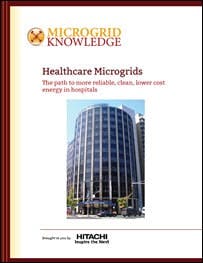This is the sixth and final article in a series that looks at how healthcare microgrids open the door to more reliable, clean, lower cost energy in hospitals, and more resilient communities.
When a storm knocks out your neighborhood power, you can hunker down and ride out the loss without too much stress. You can also borrow some ‘bread and milk’ from a neighbor if the local convenience store is closed.
Download the full report now
But what do you do if you are several city hospitals and your power goes out for an extended period of time?
Patients and staff at New York City hospitals found out the hard way during Superstorm Sandy and its aftermath. Four hospitals were closed to patients for at least three weeks afer the storm. NYU Langone Medical Center on Manhattan decided to evacuate patients at the height of Superstorm Sandy. At another East Side hospital, Bellevue Hospital Center, the National Guard was called in to help evacuate more than 700 patients.
The Manhattan VA Medical Center and Coney Island Hospital also had to close because of the storm.
In the aftermath of Sandy, hospitals are looking at ways to increase the reliability and resiliency of the power generation resources. A clearly emerging best practice is building a diverse range of generating assets and putting them under the direction of healthcare microgrids.
Two of the hospitals were either partially or completely closed three weeks afer the storm, limiting quality of care and putting a huge stress on other hospitals in the city. The hospitals had to close for many reasons, primarily flooding and power loss, even of their emergency back-up generation units.
In the aftermath of Sandy, hospitals are looking at ways to increase the reliability and resiliency of the power generation resources. A clearly emerging best practice is building a diverse range of generating assets and putting them under the direction of healthcare microgrids. For example, more than half of the 11 finalists in the NY Prize microgrid competition proposed to include hospitals in their projects.
Healthcare microgrids in action
Here we detail several existing healthcare microgrids and two proposed by communities with hospitals hard hit by Superstorm Sandy.
- Dell Children’s Medical Center in Austin, Texas
Dell Children’s Medical Center. Photo Credit: Andreanna Moya
The Seton Healthcare Family of Austin chose to power its new medical facility with a gas turbine microgrid. If there is an outage or an interruption in grid electrical service, the Dell Children’s Medical Center microgrid can continue to run, providing all of the hospital’s needs for power, steam and cooling, an important consideration in July and August in Austin.
Designed, owned and operated by local municipal utility Austin Energy, the CHP microgrid provides power and thermal energy for the hospital.
The ability of its electrical service to island or separate from the central grid was an important consideration for Seton. According to one study, the probability of failure for a traditional hospital grid-plus-backup system is 67 percent. Having the microgrid flips that equation for Seton. The microgrid allows the hospital to continue to operate if there is a grid failure. During a disaster, then, the hospital can also become a place of refuge and a center for medical care.
This microgrid exports excess electricity back to Austin Energy’s grid; excess chilled water provides air conditioning to a half-dozen other nearby facilities.
- Longwood Medical Area of Boston
In Boston, the 213-acre Longwood Medical and Academic Area (LMA) includes five Harvard Medical School — affiliated hospitals that provide care to more than 100,000 inpatients and 2.4 million outpatients each year. The campus also encompasses medical research centers and teaching institutions.
To meet the area’s critical energy needs, the LMA Medical Area Total Energy Plant (MATEP) generates electricity and useful thermal energy from natural gas CHP. The steam and chilled water travels via underground pipes to individual buildings for heating, hot water, sterilization and air conditioning.
The microgrid can island from the main grid during power disruptions and supply reliable service to the facilities. By operating independently from the main grid, the microgrid creates resilience for the healthcare operation, as well as the surrounding community.
The system also is extremely efficient. According to U.S. Department of Energy estimates, MATEP’s 47.5 MW CHP system has reduced total site fuel consumption by 24 percent.
- Utica Healthcare Microgrid
Utica College and Faxton-St. Luke’s Healthcare have operated a 3.4 MW microgrid since 2009. The system relies on four small CHP generators to supply the bulk of the energy needs for the campus and hospital and 50 percent of a nursing home’s energy needs. If the grid loses power, the microgrid can island and operate independently. It typically operates parallel to the grid, able to sell excess power back to the grid.
- Princeton Healthcare System
Because of stringent patient-care needs, hospitals traditionally use at least two energy sources: their local utility, which acts as the primary power source; and their emergency generators, which can deliver a limited power supply in the event of an unexpected grid failure.
But when the Princeton Healthcare System first envisioned building a new 630,000-square-foot acute-care hospital with 237 single-patient rooms in Plainsboro, New Jersey, it considered a third level of redundancy offered by a non-traditional energy-efficient microgrid.
The result was a healthcare microgrid with electricity provided from a 4.6 MW gas turbine-powered CHP that also acts as the hospital’s primary energy resource, meeting 100 percent of its heating, cooling and sterilization needs. This microgrid plant is backed up by 6 MW diesel-fired generators that can be supplemented by an interconnection to the local utility’s power grid, if the need arises.
The system also uses electricity from a one million-gallon chilled water thermal-energy storage tank — literally a thermal ‘battery’ that can be charged during off-peak hours and discharged during peak-demand periods — plus a 200 kW solar array with panels distributed over the parking lot.
[clickToTweet tweet=”Hospitals are looking at ways to increase the reliability and resiliency of power generation resources. #microgrids” quote=”Hospitals are looking at ways to increase the reliability and resiliency of power generation resources. #microgrids”]
The integrated nature of this solution dramatically reduces the facility’s monthly electric bills. And it provides the institution with the exibility to export power to the local grid (creating a revenue stream back to the health system) when rates are high or quickly draw power from the grid when rates are low (or if additional energy is needed).
- Tampa General Hospital
Florida hospitals are no strangers to hurricanes. More storms hit Florida than any other U.S. state. Since 2000 several hurricanes have touched down in the state, including Hurricane Matthew in 2016. This severe storm caused major damage along the eastern coast and central Florida. Add to this list 63 tropical or subtropical cyclones and Florida hospitals must be prepared for destructive weather.
This keeps the microgrid managers at Tampa General Hospital (TGH) on constant alert, watching the weather and islanding the system routinely to protects the hospital’s patients and staff. The 1,011-bed nonprofit hospital has a medical staff of 1,312. It serves a dozen counties for a patient population of more than 4 million.
The hospital and its large comprehensive service Level 1 trauma center are part of an 11 MW medical campus. The campus draws power from the main grid, with microgrid power provided by diesel-fueled generators. Natural gas-fired cogeneration units are being reviewed for the future.
For more on healthcare microgrids, see the guide “Healthcare Microgrids: The Path to More Reliable, Clean, Lower Cost Energy in Hospitals,” downloadable free of charge courtesy of Hitachi.







